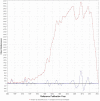Lipoprotein(a) in Cardiovascular Diseases: Insight From a Bibliometric Study
- PMID: 35865239
- PMCID: PMC9294325
- DOI: 10.3389/fpubh.2022.923797
Lipoprotein(a) in Cardiovascular Diseases: Insight From a Bibliometric Study
Abstract
Lipoprotein(a) [Lp(a)] is a complex polymorphic lipoprotein comprised of a low-density lipoprotein particle with one molecule of apolipoprotein B100 and an additional apolipoprotein(a) connected through a disulfide bond. The serum concentration is mostly genetically determined and only modestly influenced by diet and other lifestyle modifications. In recent years it has garnered increasing attention due to its causal role in pre-mature atherosclerotic cardiovascular disease and calcific aortic valve stenosis, while novel effective therapeutic options are emerging [apolipoprotein(a) antisense oligonucleotides and ribonucleic acid interference therapy]. Bibliometric descriptive analysis and mapping of the research literature were made using Scopus built-in services. We focused on the distribution of documents, literature production dynamics, most prolific source titles, institutions, and countries. Additionally, we identified historical and influential papers using Reference Publication Year Spectrography (RPYS) and the CRExplorer software. An analysis of author keywords showed that Lp(a) was most intensively studied regarding inflammation, atherosclerosis, cardiovascular risk assessment, treatment options, and hormonal changes in post-menopausal women. The results provide a comprehensive view of the current Lp(a)-related literature with a specific interest in its role in calcific aortic valve stenosis and potential emerging pharmacological interventions. It will help the reader understand broader aspects of Lp(a) research and its translation into clinical practice.
Keywords: atherosclerosis; bibliometrics; calcific aortic valve stenosis; cardiovascular disease; inflammation; lipoprotein(a); post-menopausal women; synthetic knowledge synthesis.
Copyright © 2022 Šuran, Blažun Vošner, Završnik, Kokol, Sinkovič, Kanič, Kokol, Naji and Završnik.
Conflict of interest statement
MK was employed by Semantika Research, Semantika d.o.o. The remaining authors declare that the research was conducted in the absence of any commercial or financial relationships that could be construed as a potential conflict of interest.
Figures




Similar articles
-
Lipoprotein(a) and calcific aortic valve stenosis: A systematic review.Prog Cardiovasc Dis. 2020 Jul-Aug;63(4):496-502. doi: 10.1016/j.pcad.2020.06.002. Epub 2020 Jun 8. Prog Cardiovasc Dis. 2020. PMID: 32526213
-
Experimental Animal Models Evaluating the Causal Role of Lipoprotein(a) in Atherosclerosis and Aortic Stenosis.Cardiovasc Drugs Ther. 2016 Feb;30(1):75-85. doi: 10.1007/s10557-015-6634-1. Cardiovasc Drugs Ther. 2016. PMID: 26780907 Review.
-
Lipoprotein(a) in clinical practice: New perspectives from basic and translational science.Crit Rev Clin Lab Sci. 2018 Jan;55(1):33-54. doi: 10.1080/10408363.2017.1415866. Epub 2017 Dec 20. Crit Rev Clin Lab Sci. 2018. PMID: 29262744 Review.
-
The Role of Lipoprotein(a) in the Progression of Aortic Stenosis.Am J Med. 2025 Jul;138(7):1074-1077. doi: 10.1016/j.amjmed.2025.02.024. Epub 2025 Mar 4. Am J Med. 2025. PMID: 40049573 Review.
-
What is the ultimate test that lowering lipoprotein(a) is beneficial for cardiovascular disease and aortic stenosis?Curr Opin Lipidol. 2014 Dec;25(6):423-30. doi: 10.1097/MOL.0000000000000131. Curr Opin Lipidol. 2014. PMID: 25340480 Review.
Cited by
-
Lipoprotein(a) As a Risk Factor in a Cohort of Hospitalised Cardiovascular Patients: A Retrospective Clinical Routine Data Analysis.J Clin Med. 2023 Apr 29;12(9):3220. doi: 10.3390/jcm12093220. J Clin Med. 2023. PMID: 37176660 Free PMC article.
-
Research trends in the field of the gut-brain interaction: Functional dyspepsia in the spotlight - An integrated bibliometric and science mapping approach.Front Neurosci. 2023 Mar 8;17:1109510. doi: 10.3389/fnins.2023.1109510. eCollection 2023. Front Neurosci. 2023. PMID: 36968499 Free PMC article. Review.
-
The association between periodontal disease and adverse pregnancy outcomes: a bibliometric analysis from 2000 to 2023.Front Med (Lausanne). 2025 Jan 21;12:1526406. doi: 10.3389/fmed.2025.1526406. eCollection 2025. Front Med (Lausanne). 2025. PMID: 39906598 Free PMC article.
-
Lipoprotein(a) as a Risk Factor for Recurrent Acute Myocardial Infarction and Mortality: Insights from Routine Clinical Practice.Diagnostics (Basel). 2024 Dec 7;14(23):2757. doi: 10.3390/diagnostics14232757. Diagnostics (Basel). 2024. PMID: 39682665 Free PMC article.
-
Mapping the landscape of research on insulin resistance: a visualization analysis of randomized clinical trials.J Health Popul Nutr. 2024 Jan 9;43(1):6. doi: 10.1186/s41043-024-00497-4. J Health Popul Nutr. 2024. PMID: 38195616 Free PMC article.
References
Publication types
MeSH terms
Substances
Supplementary concepts
LinkOut - more resources
Full Text Sources
Medical
Miscellaneous

